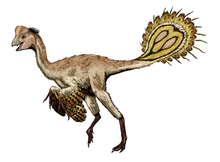Caenagnathidae
| Caenagnathidae | ||||||||||||
|---|---|---|---|---|---|---|---|---|---|---|---|---|

Head reconstruction by Anzu wyliei |
||||||||||||
| Temporal occurrence | ||||||||||||
| Upper Cretaceous (late Turonian to Maastrichtian ) | ||||||||||||
| 91.4 to 66 million years | ||||||||||||
| Locations | ||||||||||||
| Systematics | ||||||||||||
|
||||||||||||
| Scientific name | ||||||||||||
| Caenagnathidae | ||||||||||||
| Sternberg , 1940 |
The Caenagnathidae are a systematic group of dinosaurs within the Oviraptorosauria . As with all Oviraptorosauria, it was small to medium-sized, very bird-like and probably feathered theropods with a greatly shortened tail and a toothless beak. While the other group of Oviraptorosauria, the Oviraptoridae, had very short skulls and deep jaws, the Caenagnathidae had longer and thin jaws and long legs. The Caenagnathidae is documented from the Upper Cretaceous North America and Asia.
Fossil record and characteristics
In contrast to the Oviraptoridae, which is known for its numerous well-preserved and complete skeletons, only a few and fragmentary finds have been described of the Caenagnathidae. Only a fragmentary skull, a few lower jaws and a few isolated bones of the remaining skeleton (postcranium) adjacent to the skull are known of this group. Finds that can possibly also be ascribed to the Caenagnathidae include Nomingia , from which, among other things, a vertebral column is preserved in a natural anatomical network.
Due to the incomplete fossil material, only a single feature is known that is undoubtedly characteristic of the group ( synapomorphism ) and distinguishes it from other groups: the paired lower jaw is fused to the symphysis . Other synapomorphies could include the lack of an additional mandibular window and the arctometatarsal position of the foot: When viewed from the front, the third metatarsal was only visible in the lower part of the metatarsal, while in the upper part it was covered by the touching second and fourth metatarsal bones. An arctometatarsus is found in Caenagnathiden, Avimimus and various other groups outside of the Oviraptorosauria, but is absent in the Oviraptoridae.
Research history
The Caenagnathidae was first described by Sternberg in 1940 . The name Caenagnathidae is derived from the now invalid genus Caenagnathus and means something like "modern jaw": The jawbones of Caenagnathus were very similar to those of today's ancient jawbirds (Palaeognathae). However, since it is unusual to discover the jaws of a modern group of birds in the Cretaceous period, the dinosaur was called Caenagnathus - "modern jaw". Today Caenagnathus is considered identical with Chirostenotes ; since Chirostenotes was described before Caenagnathus , Chirostenotes is the only name that is valid today ( priority rule ).
species
- Anzu wyliei
- Including sinesis
- Chirostenotes pergracilis
- Chirostenotes sternbergi
- Chirostenotes sp. , a possible new, as yet unnamed species from Montana (USA), of which a fragment of a lower jaw is known.
- Caenagnathasia martinsoni
- Elmisaurus elegans
- Hagryphus giganteus
- ? Nomingia gobiensis , another possible Caenagnathide.
- ? Elmisaurus rarus , the classification of this species as Caenagnathide is controversial.
literature
- Halszka Osmólska , Philip J. Currie , Rinchen Barsbold : Oviraptorosauria. In: David B. Weishampel , Peter Dodson , Halszka Osmólska (eds.): The Dinosauria . 2nd edition. University of California Press, Berkeley CA et al. 2004, ISBN 0-520-24209-2 , pp. 165-183.
Web links
Individual evidence
- ^ Osmólska et al .: Oviraptorosauria. 2004, p. 165.
- ^ Osmólska et al .: Oviraptorosauria. 2004, p. 166.
- ↑ a b rinchen barsbold, Philip J. Currie, Nathan P. Myhrvold, Halszka Osmólska, Khishigjaw Tsogtbaatar, Mahito Watabe: A pygostyle from a non-avian theropod. In: Nature . Vol. 403, No. 6766, 2000, pp. 155-156, doi : 10.1038 / 35003103 .
- ↑ a b Osmólska et al .: Oviraptorosauria. 2004, p. 180.
- ^ Osmólska et al .: Oviraptorosauria. 2004, p. 178.
- ^ Joel Cracraft : Caenagnathiformes: Cretaceous birds convergent in jaw mechanism to dicynodont reptiles. In: Journal of Paleontology. Vol. 45, 1971, ISSN 0022-3360 , pp. 805-809.
- ^ Rinchen Barsbold, Teresa Maryańska , Halszka Osmólska: Oviraptorosauria. In: David B. Weishampel, Peter Dodson, Halszka Osmólska (eds.): The Dinosauria . University of California Press, Berkeley CA et al. 1990, ISBN 0-520-06726-6 , pp. 249-258.
- ↑ Hanyong Pu; Darla K. Zelenitsky; Junchang Lü; Philip J. Currie; Kenneth Carpenter; Li Xu; Eva B. Koppelhus; Songhai Jia; Le Xiao; Huali Chuang; Tianran Li; Martin Kundrát; Caizhi Shen (2017). Perinate and eggs of a giant caenagnathid dinosaur from the Late Cretaceous of central China . Nature Communications. 8: Article number 14952. doi: 10.1038 / ncomms14952
- ^ Philip J. Currie, Stephen J. Godfrey, Lev Nessov: New caenagnathid (Dinosauria: Theropoda) specimens from the Upper Cretaceous of North America and Asia. In: Canadian Journal of Earth Sciences. Vol. 30, No. 10, 1993, ISSN 0008-4077 , pp. 2255-2272, doi : 10.1139 / e93-196 .
- ↑ Lindsay E. Zanno, Scott D. Sampson: A new Oviraptorosaur (Theropoda, Maniraptora) from the Late Cretaceous (Campanian) of Utah. In: Journal of Vertebrate Paleontology. Vol. 25, No. 4, 2005, ISSN 0272-4634 , pp. 897-904, doi : 10.1671 / 0272-4634 (2005) 025 [0897: ANOTMF] 2.0.CO; 2 .

